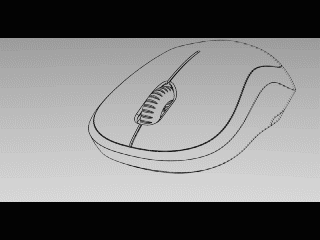This weeks has bee super busy. I'm mentally exhausted. The finishing touches to the model this week involved a lot of tiny little bosses and cuts to create the important clips for the inside of the mouse. (which by the way is terrible and has excruciatingly low tracking resolution)
Some fine wires to make contact with the battery have been added to the PCB assembly. Their construction is quite simple. A few sketches to use as construction for a sweep feature. Some techniques that I've not used in Solidworks before were the helix and coil tools. Very interesting.
Some issues revealed themselves when dealing with the bottom section of the mouse. One was a self intersection error when trying to thicken the surfaces I'd modeled. Another was zero thickness geometry when i tried a different approach to creating the part. Ultimately I gave up on it, but the part looks accurate enough in my opinion. The following image is the oversize thickness that was created with another approach. I trashed that.
Moving on to creating renders and animations... I had a frustrating time, leaving my motion study render running for a whole 2 days, then realising it. glitches out and all my camera angles were snapping isntead of transitioning smoothly. Don't know why, but it worked the second time around when i toned down the render quality. I used some editing software to transition from a line drawing to a fully rendered animation just for the hell of it. Still photo renders were not a hassle, although the Photoview feature which rounds off sharp edges couldn't figure out how to make it work for the organic curves of the mouse. Point is I know its there and the software is just not quite smart enough. Here's a gif of my animation and some comparisons between rounded edges on a part.
All in all I'm happy with the result. I didn't feel as though much needed to be adjusted to the scene for the renders. I believe there is a reason the defaults are set the way they are, thought i did play around for a while before coming to this conclusion.
Finished Renders!



































